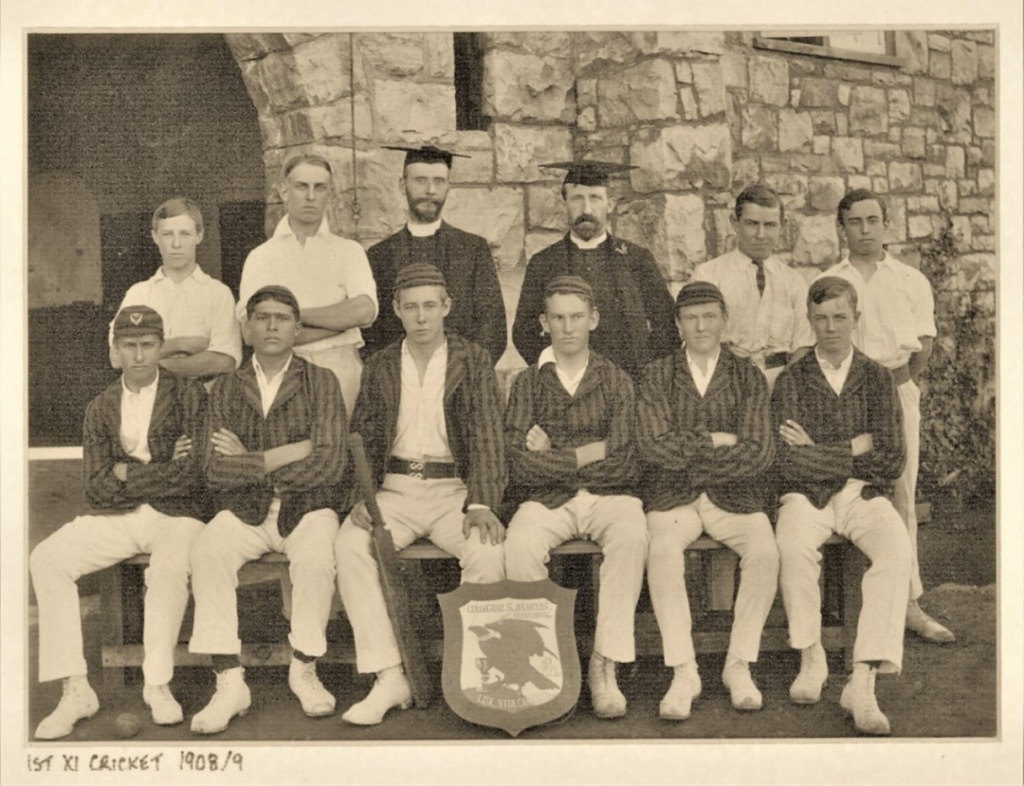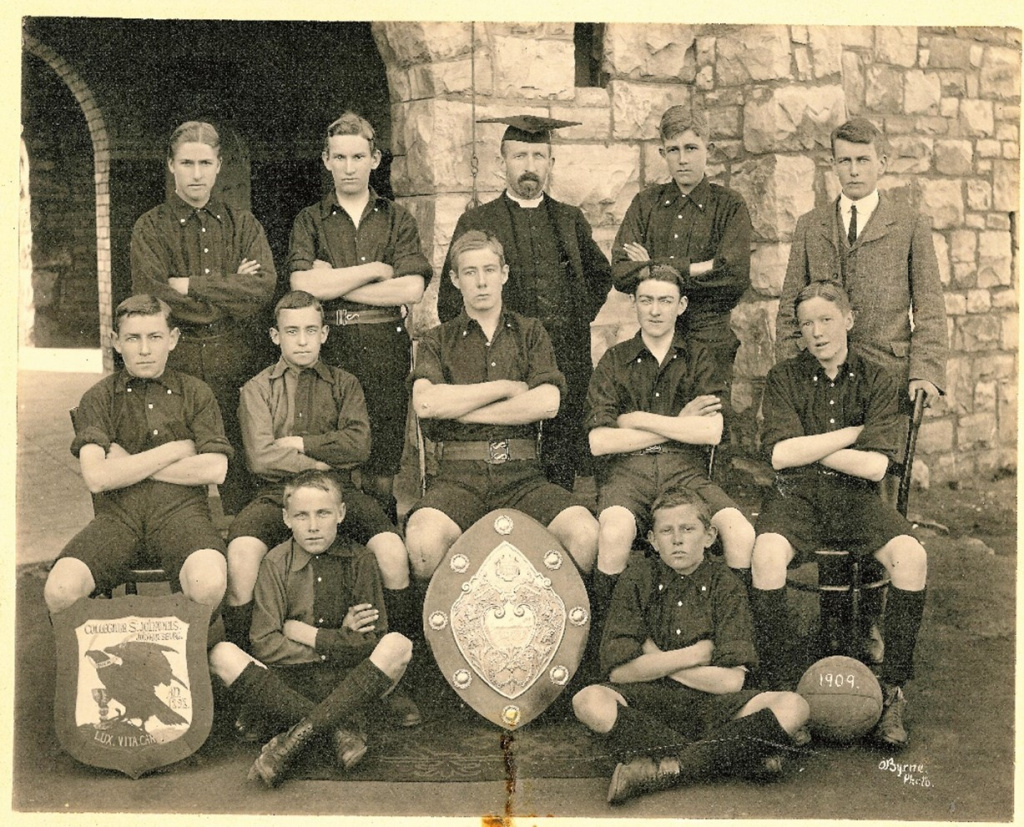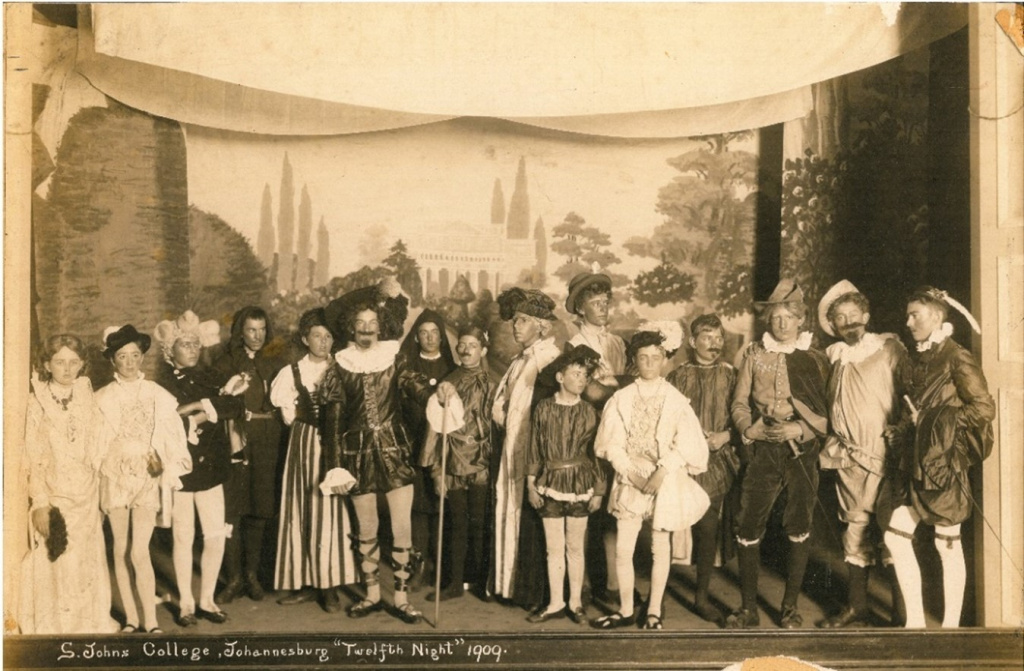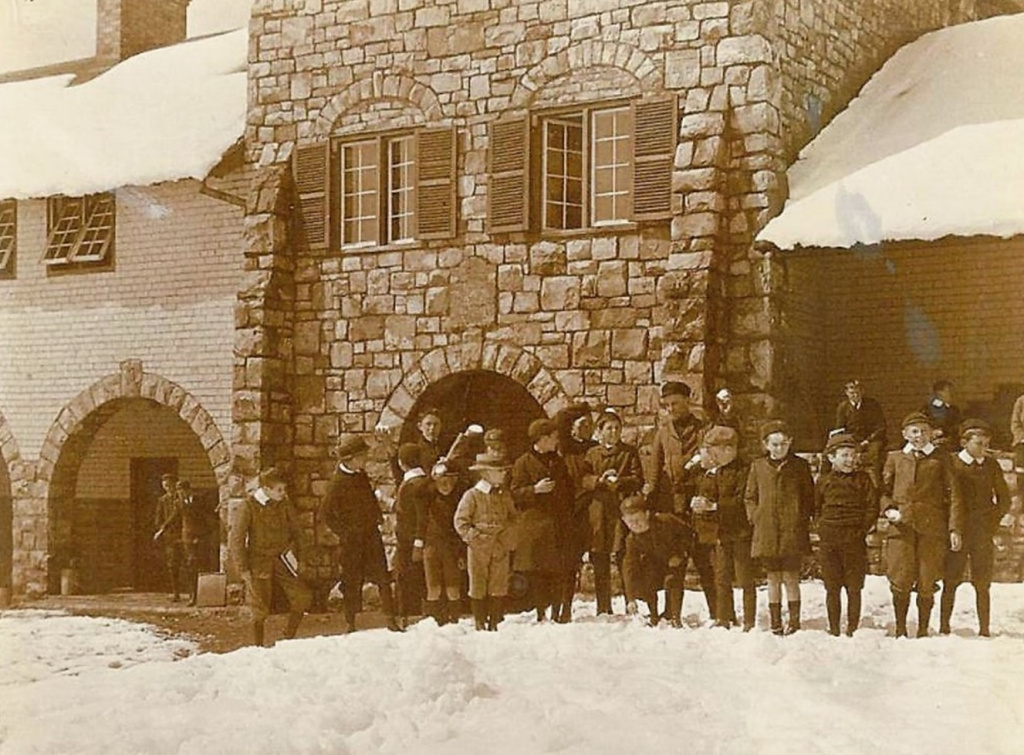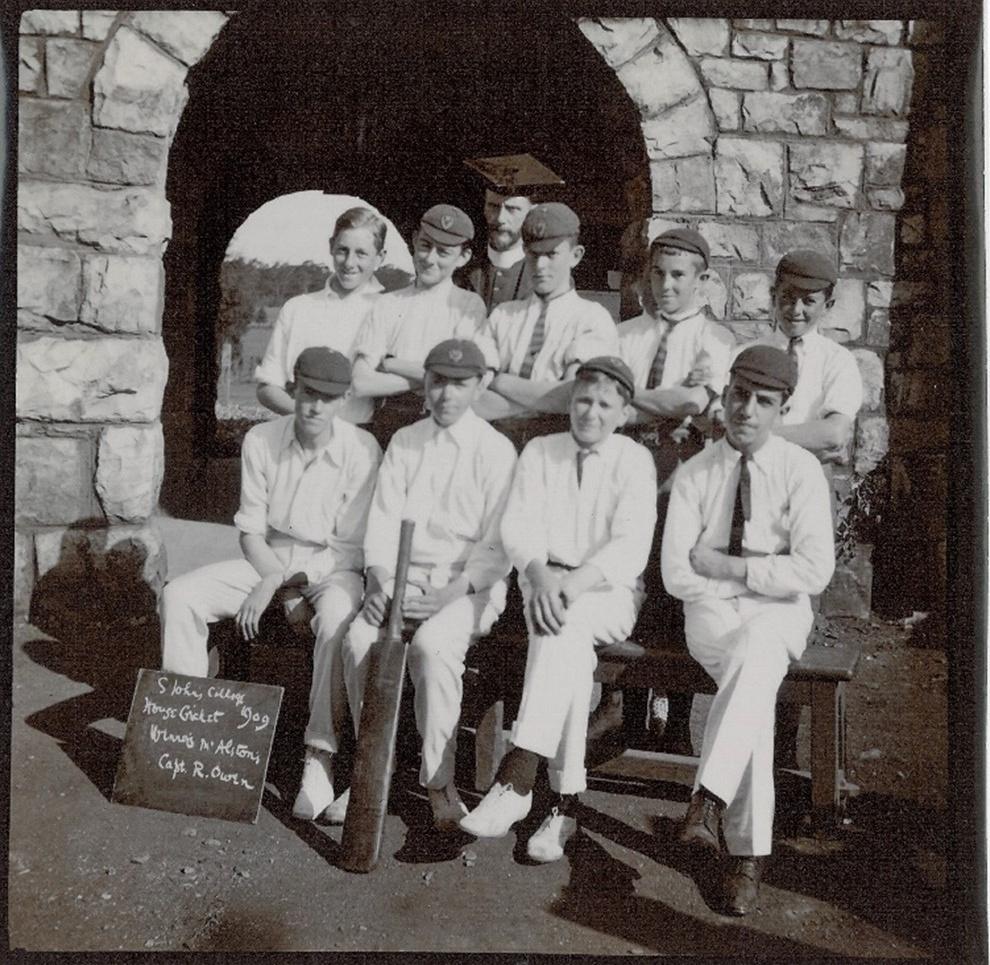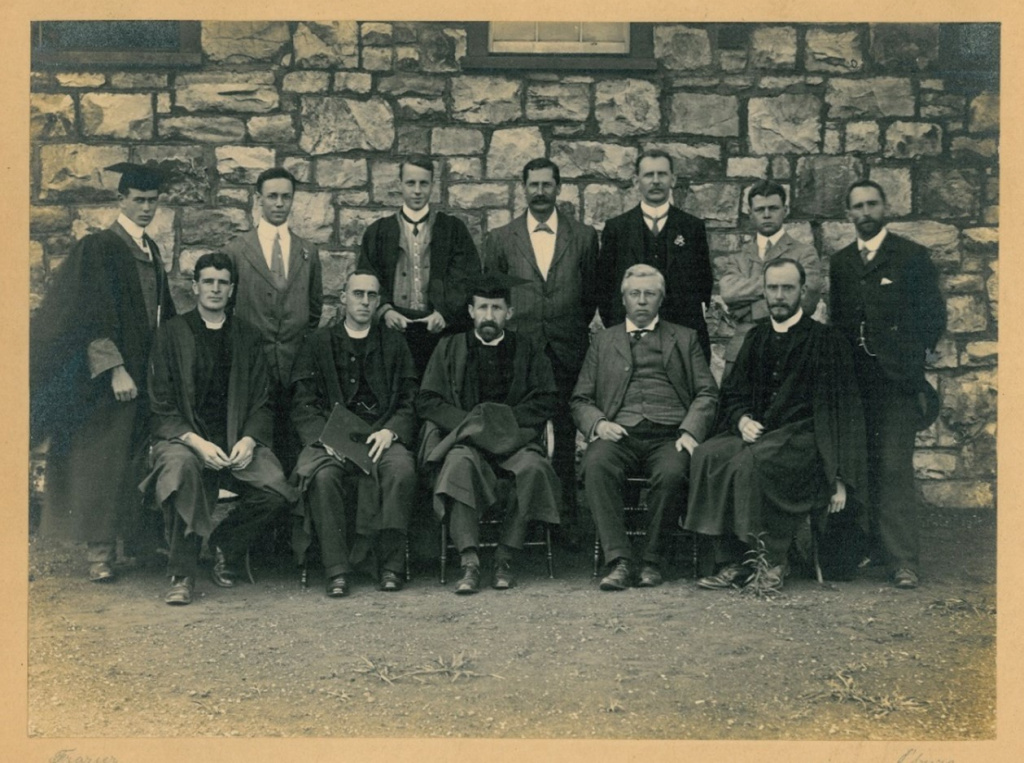by Dr Daniel Pretorius, Chairman of the Heritage Committee
In The Star of 15 January 1909 it was announced that St John’s College would be opening for Lent Term on Tuesday 26 January, that boarders would be assembling at the school the previous day, and that the Headmaster, the Revd James Okey Nash C. R., would be in attendance at the school on Saturday 23 January to interview parents.
Fr Nash, who had been on furlough in England in the latter months of 1908, had availed himself of the opportunity to recruit new teachers for his expanding school. He had engaged the services of Messrs P. S. Richards (Scholar of Corpus Christi, Oxford), E. Bruce Murray B. A. (Durham), John Howat Lowden B. A. (Balliol College, Oxford), Bernard Jackson (from Norbury College, London), Ralph Griffiths (from The High School, Dublin, and previously Colston’s School, Bristol) and Mr Zwarenstein (from Holland, to teach Dutch). Soon afterwards, Fr Nash also appointed Mr G. L. Cochrane B. A. (Trinity College, Dublin), who had previously been on the staff at St Andrew’s College, Grahamstown, and Gill College, Somerset East.
In his first newsletter of the new year, the Headmaster reported on the external examination results that had been achieved by St John’s boys at the end of 1908. Five of the six boys who had been sent in for the Cape Matriculation had passed; three had done so in the second class: Louis Thorp (Nash), Isidore Rosenberg (Thomson) and Fred van den Berg (Alston). (A few years were to elapse before a St John’s boy would achieve a first-class matriculation.) Nine of the twelve boys who had been entered in the Cambridge Preliminary examination were successful. Guy Nicolson (Thomson) passed in nine subjects: Arithmetic, Algebra, Dictation, Religious Knowledge, English, History, Geography, Latin and French. He was one of only three candidates in all the British colonies in southern Africa to receive ‘the coveted star of distinction’ in Latin. Rupert Thorp (Nash) passed in eight subjects.
Several benefactors were reported to have made a range of donations to St John’s College. Mr Richard Hollins (of Ketton Hall, Rutland, deputy county lieutenant of Rutland, and a founder of the Transvaal Chamber of Mines) had given £500. An anonymous donor had matched that amount, to pay for the construction of additional classrooms, designed by Messrs Baker & Masey. Gifts from various friends and well-wishers had made it possible to ‘terrace our wild waste front’ on St David Road and to plant ‘hedge trees all round our grounds’.
Other contributions included a variety of ‘excellent pictures’, among them prints of Rembrandt, Turner, Millais, Poynter, Vandyck, Constable, Holbein and Andrea del Sarto. These were used not only to decorate the austere walls of the school buildings but also to introduce the boys to a world of art which would otherwise have remained foreign to most of them.
The Lent Term cricket season was approached with some trepidation: the College 1st XI had lost several senior members at the end of the previous year, and some novices now had to uphold the school’s honour. Fortunately, though, ‘some boys improved so much under Atfield’s coaching that the XI was very fair.’
On 4 February, the Bishop of Pretoria’s XI came to St John’s for the annual match, which had become a ‘popular event ... because the Bishop demands a half-holiday, and being Visitor of the School, had to be obeyed.’ A few boys had recently constructed a barometer, which predicted certain rain, but the sky mocked the prophecy and made only the faintest attempt at fulfilment. Bishop Carter (by then Archbishop-elect of Cape Town) had mustered a ‘very clerical’ team, which included redoubtable cricketers such as the Revd P. McCormick (who had taken six wickets and scored 50 for M. C. C. against Royal Engineers at Lord’s in July 1907) and the Revd J. N. B. Champain (ex-Gloucestershire). The team was fortified by the inclusion of Messrs Wilfrid Brown-Constable O. J., J. H. Lowden (an Old Andrean and former Rhodes Scholar who was now a master at St John’s) and the ex-Transvaal player, W. H. Greathead (who was a member of the College Council).
The Lord Bishop won the toss and confidently elected to bat. Two wickets were down for 15, but the Revd Mr McCormick scored 95 to enable the Bishop’s XI to post a total of 175. As always, the Bishop batted at number 11 but succumbed for 3 to a ‘very crafty’ ball from Harry Montgomery Marsh (Rakers), ‘who has much improved of late’ and who took five wickets. It was to the credit of the captain and wicketkeeper, Oswald Austin Reid (Thomson), that there were only four extras. Going in to bat, St John’s scored 119: ‘little Nicolson’s innings of 25 was pretty work, and the not much bigger McKechnie’s also 25 [not out], though rougher, had some hard hitting in it.’ The Revd Mr McCormick took six wickets with ‘terrible curly balls’, while the Revd Eustace Hill C. R. took two wickets. The Archbishop took a ‘gallery catch’ in the slips.
St John’s hosted Mr Given-Wilson’s XI on 9 February. The visitors scored 144. F. O. Dickenson (who had played for Transvaal against Lord Hawke’s XI in 1899) scored 51. Marsh took three wickets, and Arthur McKechnie (Nash) and Harry Greville Freeman (Alston) two each. St John’s scored 128 (Nicolson 45, McKechnie 29), and at one stage looked like winning but eventually lost by sixteen runs.
Against Volunteer Juniors, on 13 February, St John’s scored 128, of which Leslie Green (Nash) made 38. Volunteer Juniors were dismissed for 46, St John’s thus winning by 79 runs. Green took 5/14, including four wickets in successive balls. Marsh took 4/32, having also scored 19*.
The match against the Parents’ XI (captained by Mr Greathead) was played on 17 February. There was some doubt about the weather when play started, but fortunately, the rain held off. The boys batted first and did not do too badly, scoring 127. Green made a ‘very nice’ innings of 26. Nicolson (‘a diminutive youngster of promise’) played stylishly for 13. Llewellyn Shawe (Alston) (29) and Eric Bell (Thomson) (16*) put up strong resistance for the last wicket. The ‘old ‘uns’ won thanks entirely to an innings of 111* by Mr John Reid (the President of the Transvaal Cricket Union, who was ‘in terrible form’), in the total of 164. McKechnie and Marsh took two wickets each.
St John’s ‘ought to have made a better game with’ Johannesburg College but collapsed and were beaten by five wickets. There was a ‘close and exciting game’ with Jeppe, who won in the last over, with nine wickets down. St John’s scored 98 (Nicolson 23, 28 extras), and Jeppe ended on 109. The match against Mr Wheeler’s XI was won by eight wickets. The 2nd XI beat Jeppe by 57 runs but the 3rd XI lost by 28 runs. A Junior XI beat Park Town School by two runs in a ‘most thrilling game’.
Writing in his Letter of Lent Term, Fr Nash expatiated on the raison d’etre of St John’s College:
‘When we are asked … what kind of a School ours is, we say – a Church School … Character or moral culture is the chief end of education. Therefore we should hold that to cause this light of the image of Christ to shine in the child’s heart is the most powerful way to educate the child and thereby to civilize the nations. ... [The Anglican and Catholic churches] are doing our best to maintain schools where the image of Christ and the laws and traditions of His Kingdom have their full place, and are set forth by those who are subjects and followers of the King. That is why St John’s exists … We stand for the Church’s claim to train her children: and we trust that the image of Christ will make our boys gentlemen if a gentleman, be one who “respects himself and respects others”; ready to learn, as they come to see that wisdom and knowledge are Godlike; manly, as they admire and follow the Bravest of All; upright, as they train themselves by Christ’s words and ways and deeds.’
Fr Nash’s Letter also contained news about carpentry lessons, boxing classes and debating (there had been successful motions in favour of the unification of the South African colonies and for ‘giving reasonable education to natives’). It was reported that Guy Nicolson had won the Transvaal junior lawn tennis championship and that the thirteen-year-old Hyman Leslie Patlansky (Nash) had been commended in Port Elizabeth newspapers for having swum out to save a lady who was drowning. He later received the Royal Humane Society’s Parchment for bravery.
As far as old boys were concerned, there was news that Charles Winslow O. J. had won three Transvaal lawn tennis championships. Meanwhile, J. W. Zulch O. J. and N. V. Lindsay O. J. played for Transvaal in the Currie Cup cricket tournament in March. Zulch scored 112 in the match against Border.
During Easter and Trinity terms, the College’s under 16 football team was unbeaten in the Johannesburg schools second league, scoring 36 goals while conceding only one. Admittedly, most of these goals were scored in only two matches. First, in the match against Troyeville Grammar School the scoreline was 9-0. Then St John’s won 20-0 against Turffontein Government School, who, in their defence, fielded a team comprising only nine players. The College under 16 team faced Jeppe in the League Shield final, played at the Wanderers. St John’s won 3-1. Fr Nash reported: ‘The silver shield was presented on the ground by the Secretary of the Schools’ League, Mr Fletcher, and brought up in triumph; and after much polishing was hung up in the dining hall, where it [was] to repose for a year.’
The under 14 team performed well in the third league, scoring thirteen goals while conceding only four. The under 11 team was victorious over P. T. S. by a margin of 3-0. Fr Nash commented wryly: ‘All these successes showed a tendency to make caps feel small on the head, so it was no bad thing that we got a real good hammering from Jeppe in the First League under 19 by 9-0, not indeed that anyone hankered after quite so decisive a defeat.’ He added by way of extenuating circumstance: ‘We were unfortunate in having two good players laid up with bad legs that day, Green (ma.) our best forward was an especial loss.’
Nash’s House won the inter-house football competition.
By now the Tower Chapel (situated above the main entrance to the present Prep School) had long since become much too small to accommodate the entire school. Consequently, it had become customary for the school to march up the hill to St Aidan’s Church, Yeoville, for Choral Eucharist on occasions such as St Bartholomew’s Day, Ash Wednesday and Maundy Thursday.
On Ascension Day, a choral service was again held at St Aidan’s. Afterwards the annual football match against the Old Boys was played, resulting in a 2-2 draw. The Old Boys’ team consisted of Colin Kearns (captain), Frank McKowen, Harold Holt, Ernest Hurley, John Powrie, Bernard Stokes, Aaron Israel, Norman Phipps-Hornby, Wilfrid Brown-Constable and Cracroft Marshall.
After the match, the Old Boys’ bat for the highest batting average during Lent Term was awarded to Guy Nicolson (who, ‘albeit small, has played some good innings’). The prize for the best bowling average was shared by Harry Marsh and Leslie Green.
John Moodie won the Eisteddfod essay on ‘My S. African Hero’; his chosen hero was Cecil Rhodes. Fr Nash thanked Dr Cotterill of the St George’s League for having donated to the school ‘a splendid S. George’s flag, such as we have long coveted.’ Gilbert Reynolds and Harry Good passed the Trinity junior and preliminary piano examinations, respectively. In June 1909, performances of Shakespeare’s Twelfth Night were presented to ‘large hearty audiences’.
Also in June, the government allocated a sum of £45,000 for the development of the new Johannesburg College site in Houghton. In October, Fr Nash confirmed that this school (later to become known as King Edward VII School) was poised to ‘come and build at our very doors,’ adding darkly that there were ‘strong advocates of an all-Government system of schools.’ He said that St John’s had ‘always frankly confessed the excellences of the larger school, and hoped to emulate them,’ but expressed concern that this enforced close proximity might ‘alter our hitherto friendly relations with Johannesburg College.’
On a more cheerful note, Fr Nash reported that the non-governmental Witwatersrand Council for Education had donated £1,500 to St John’s ‘in view of its good work for many years.’ This donation enabled St John’s to purchase five acres of land corresponding roughly to the present-day Rice Field, as well as the land immediately to its north, from Johannesburg Consolidated Investment Co. However, that field (initially known as the ‘Far Field’) was only endowed with grass in 1966.
Fr Nash wrote that, with the College’s tuition fees being on a par with those of government schools, the College was only able to make ends meet, without there being any margin for repairs, for paying off a loan of £3,000, and for further extensions to the school buildings. Consequently, Council, while not desiring to ‘make St John’s an expensive or exclusive school,’ had decided to increase fees by £1 per quarter. This would provide the necessary margin without putting the school ‘beyond the reach of parents of moderate means.’
On 17 August 1909, Johannesburg experienced heavy snowfalls. ‘Football gave way to snowballing and snowmen – with snow a foot deep all around!’
The College’s annual athletic sports day was held on 18 September. ‘The weather was glorious and brought us a great company of parents and friends.’ The inter-house team race was won by Nash’s House, which beat Lowden’s House into second place. Llewellyn Shawe (Alston) and Guy Stanford (Nash) tied for the victor ludorum championship.
In Advent Term, the St John’s 1st XI played against Jeppe on 3 November and suffered a heavy defeat. Having reached 31/2, St John’s collapsed to 44 all out. Jeppe reached this total for the loss of four wickets and proceeded to pile up 308/4. Still, McKechnie took two wickets and maintained an excellent length; the Jeppe batsmen could not take liberties with his deliveries.
The match between Johannesburg Schools and the Transvaal Cricket Union XI was played on 17 November. Five St John’s boys were included in the Schools XVIII: O. A. Reid, H. M. Marsh, A. R. McKechnie, G. H. Stanford and V. F. W. Edwards. The Transvaal XI scored 106, Marsh taking 1/12. The Schools scored 280/17. The highest score for the boys, namely 52, was achieved by a former St John’s boy, W. D. Duff, who was now a pupil at Johannesburg College, and who later played for Transvaal.
On Dingaan’s Day, 1909, the College 1st XI won the annual match against the Fathers XI by 95 runs. In threatening weather, the boys scored 150 (Marsh 45, Reid 29). ‘The fathers, who betrayed ... that nervousness and rustiness which suggests long abstention from sport, managed – as one of the youngsters present remarked – to put 55 together “by a series of flukes”.’ Marsh and McKechnie ‘played skittles with the stumps ... and proved themselves to be no respecters of age.’ Marsh ended with six wickets.
At the subsequent prize-giving (the term ‘Speech Day’ was not yet in use), Fr Nash said that many people had ridiculed the idea that a school such as St John’s, unendowed and unaided by government, could pay its way with its present fees, which were much lower than those of other private schools in Johannesburg. He said that St John’s was a church school not conducted for profit. While it could meet its expenses at the present fee rates, it had no margin for repairs etc. This was why it had been decided to increase fees by £1 1s per term.
During the course of 1909, Fr Nash and Charles Gore (the founder and first superior of the Community of the Resurrection and, by 1909, the Bishop of Birmingham) published their edited version of William Law’s Defence of Church Principles, Three Letters to the Bishop of Bangor, 1717-1719.
Principal sources:
AP Cartwright Strenue – The Story of King Edward VII School (1974); Council of Education, Witwatersrand History of Council, 1896-1916 (1916); JW Horton First Seventy Years: 1895-1965 (1968); KC Lawson Venture of Faith: The Story of St John’s College, Johannesburg (1968)
The Star 15 January 1909, 5 February 1909, 12 February 1909, 15 February 1909, 18 February 1909, 24 March 1909, 26 March 1909; Rand Daily Mail 5 February 1909, 15 February 1909, 18 February 1909, 15 November 1909, 17 December 1909; Transvaal Weekly Illustrated 13 February 1909; Jeppestown High School Magazine June 1909, December 1909; Transvaal Leader 18 November 1909
St John’s College Letter of Trinity Term 1908; Letter of February 1909; Letter of Lent Term 1909; Letter of Easter Term 1909; Letter of Trinity Term 1909; Letter of Trinity & Advent Term 1911

